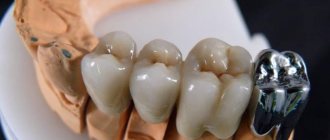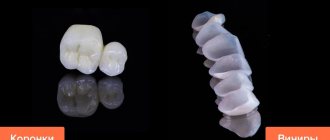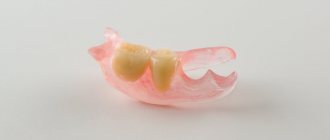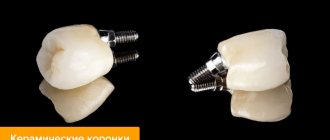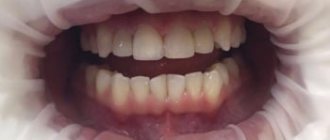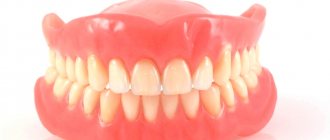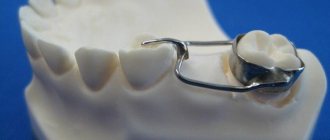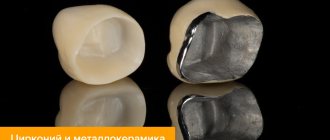From this article you will learn:
- what crowns are better to put on the front teeth,
- pros and cons of different crown options,
- How much does it cost to insert a front tooth?
When replacing anterior teeth, patients always place quite high demands on the aesthetics of dental crowns. The most important of them is that crowns on the front teeth should not be noticeable against the background of your own teeth, matching them in shape, color and transparency. The second important point is that crowns should not cause the gums to appear blue around them, because this will lead to its extremely aesthetically unsatisfactory appearance.
Today in dentistry there are only a few aesthetically acceptable options for prosthetics of anterior teeth. We are talking about prosthetics with metal-ceramics, zirconium crowns, as well as ceramic crowns “Emax” (glass-ceramics). Moreover, patients are equally often dissatisfied with both metal-ceramic and ceramic crowns, and below we will tell you why this happens and how to choose the most suitable option for you.
Metal-ceramic crowns for the front teeth: photo
The reasons for patient dissatisfaction lie not only in the low quality of work, but also in the initially incorrect choice of the type of crown, for example, not taking into account the level of transparency of the patient’s tooth enamel. The difficulty of choosing also lies in the fact that each of the types of crowns mentioned above (depending on the quality of the materials used and the manufacturing method used) can have either good or bad aesthetics. For example, let’s take economy-class metal ceramics made from budget ceramic mass “Duceram” (Germany).
Such metal ceramics can be found at an average price of 10,000 to 12,000 rubles. At the same time, the aesthetics of metal-ceramics made from budget ceramic mass will be very different from crowns that used more expensive ceramic mass, for example, “Noritake” (Japan), “Ivoclar” (Liechtenstein) or “Vita” (Germany). The average price for such metal ceramics in Moscow will be from 15,000 to 18,000 rubles. And if the metal ceramics were also made with the so-called “shoulder mass”, then you will have to add about 5,000 rubles to the price.
Important: we point out that within each type of crown there are numerous manufacturing options, the aesthetics of which will largely depend not only on the professionalism of the doctor and dental technician. Really good aesthetics will require more expensive materials and more labor-intensive manufacturing methods. But on the other hand, even choosing expensive ceramic crowns will not be an unconditional guarantee that you will get good aesthetics (since everything has its own nuances, which doctors often keep silent about).
Smile zone: indications for installing crowns
When communicating and expressing emotions, the teeth in the frontal region are involuntarily exposed. Their condition is visible to others, and this can cause psychological discomfort. If you are not happy with the appearance of your front incisors, contact your dentist. Even in the most advanced cases, when teeth are severely damaged, it is not necessary to remove them. After a thorough diagnosis, the doctor may recommend restoring teeth with crowns. A cap-like structure is placed over the remaining part of the tooth and takes over its functions.
Manufacturing
Crowns are made using prepared plaster models. Metal, metal-ceramics and ceramics can be used as the manufactured material.
Manufacturing is quite labor-intensive and time-consuming, so while the dental technician is working on their creation, the patient is put on temporary plastic products. This way, the aesthetic appearance of the ground teeth is restored, and they are protected from external influences and infection. These dentures, in addition to protecting teeth, also allow them to be fully used when chewing.
Restoration with crowns is indicated in the following cases:
- aesthetic defects (chips, stains, cracks, diastemas, trema, curvature, etc.);
- single or complete destruction of teeth with preservation of the root;
- uneven gum line;
- bite pathology;
- pathological abrasion and discoloration of enamel;
- restoration of lost functions (biting, sharing food, diction).
The front incisors are not associated with the chewing function, so there are no strict requirements for the strength of the crowns. The doctor’s task is to recreate the anatomical shape and color of natural teeth, maintain their degree of transparency, and achieve a perfect match of sizes.
Options for restoration of the anterior region with crowns
For patients and dentists, the front teeth have always been the most problematic. In the last century, people were given metal crowns to preserve chewing function. There were no other alternatives. Such structures coped with the chewing function, but looked very unaesthetic, oxidized, caused allergies and galvanic syndrome (taste in the mouth). The most expensive and fashionable were gold dentures. Products made of ductile metal did not oxidize, did not cause rejection, and did not wear out for a long time. But the shiny yellow crowns were conspicuous and did not look like natural teeth, so over time, fashion changed, and this restoration technology was replaced by more modern techniques.
Today, patients have the opportunity to painlessly and quickly get rid of all defects associated with damage or loss of teeth in the frontal area, including the complete absence of dentition. In shape, shade and transparency, artificial analogs are almost no different from natural teeth, and their strength allows you to forget about any problems for a long time.
Stages of bite deformation in children and adults
Doctors distinguish several stages of bite deformation.
The first is considered the easiest. It is diagnosed when the patient has a curvature of one or more teeth - they may have an irregular shape or length, an abnormal inclination and location, or may be rotated around their own axis.
The second or middle stage involves malocclusion throughout the entire row on one jaw or both.
To the third, most severe stage, experts include pathologies associated with the abnormal structure and size of the maxillofacial apparatus relative to the skull, violation of the position of the upper and lower jaws relative to each other, and the degree of closure of the teeth.
Important! Any, even the most minor, deformation of the bite, at a minimum, leads to a violation of the aesthetics of the smile and facial proportions, and at a maximum – to serious health problems. For example, to dental diseases and gastrointestinal pathologies, to respiratory failure, hypertonicity of the masticatory muscles and overload of the maxillofacial joint, to headaches, to early loss of teeth.
Types of dental crowns
In any clinic, patients can choose the type of future crown themselves, but without the help of a doctor it is very difficult to understand the types of prostheses, as well as evaluate the advantages and disadvantages of orthopedic structures. When choosing a crown, it is important to know what material it is made of.
✔
Metal ceramics.
✔
Solid ceramic.
✔
Ceramics E-max.
✔
Ceramic coated zirconium.
Metal ceramics
Products of this type have a very solid base. They create structures by alloying various metals: chromium, nickel, cobalt, gold, titanium. To make the dental crown look natural, the metal base is covered with ceramics. Layers are applied to the frame, after which the crown is fired to impart strength and integrity.
- Acceptable cost
- Wear resistance.
- Reliability.
- Change in color of soft tissues.
- Allergy to metal.
- Blueness of the gums.
- Significant grinding of the tooth.
Solid ceramic
When restoring teeth in the frontal zone, doctors recommend all-ceramic structures for aesthetic single prosthetics. All-ceramic crowns are made from pressed ceramic without the addition of additional materials. These are quite fragile products, so they are not used in the chewing department.
- Biocompatibility.
- Great aesthetics.
- Durability.
- Fragility.
- Impossibility of performing bridge prosthetics.
- Relatively high price.
E-max ceramics
The problem of the fragility of a material such as ceramics was solved by glass-ceramic crowns E-max. They are not only very durable, but also distinguished by high aesthetics. This is an excellent option for front teeth. The E-max crown looks natural and does not stand out among natural teeth.
- Strength.
- Aesthetics.
- Reliability.
- Natural transparency.
- High price.
Zirconium
In the popularity rating, zirconium crowns have been occupying first place for several years. In terms of strength, aesthetic products made from zirconium dioxide are not inferior to metal, which makes it possible to create orthopedic structures of the highest quality. The hard material enhances the strength of teeth and restores their size and shape.
- Excellent biocompatibility and thermal conductivity.
- Inertness of the material.
- Kink resistance.
- Lack of natural transparency.
- High price.
Ceramic crowns on a zirconium frame
This type of crown is an excellent opportunity to combine strength, reliability, and high aesthetics. The products are as reliable and durable as metal-ceramic crowns. They do not deform during use and serve for a long time. The ceramic layer gives the artificial tooth a natural appearance.
- They look natural.
- Hypoallergenic.
- Withstands heavy loads without risk of damage.
- Quite a high cost.
Service life and care
When thinking about whether it is possible to correct crooked teeth with veneers, you need to remember that this “correction” is not permanent (like braces). Although even after braces you will have to wear retainers for a long time - special devices that restrain “spreading”. After some time, fillings or microprostheses will have to be replaced. And also take proper care of them to maximize their service life.
DENTAL PROSTHESIS ON 6 IMPLANTS - 290,000 rub.
The price includes all manipulations for installing Osstem implants (South Korea), manufacturing, installing and fitting the prosthesis, including anesthesia and diagnostics.
Save RUB 30,000. >> Call now or request a call
Opening hours: 24 hours a day - seven days a week
Thus, therapeutic restorations last an average of 5-7 years. But since their surface quickly loses its “smoothness” and begins to fade and absorb dyes, you will have to give up brightly colored products and regularly visit the dentist (at least 2 times a year) to remove the accumulated plaque and carry out polishing.
For classic ceramic, ceramic-composite and zirconium dioxide onlays, the service life starts at 10 years. But they can easily last more than 15 years if professionally manufactured and installed. Therefore, first of all, you need to approach the choice of an orthopedic dentist wisely. Restorations, despite their strength, should be treated with care - exclude hard foods (or cut them into pieces first), do not chew chewing gum, taffy, chew candy, and do not bite off pieces of hard foods with your front teeth. It is advisable to come to the clinic for a medical examination once a year.
How is prosthetics performed: stages of crown installation
Restoring teeth in the smile area is no different from restoring chewing units. The doctor performs standard procedures, but does so taking into account high aesthetic requirements. Crowns in the smile area should restore all lost properties of the tooth: color, shape, size, functionality. For prosthetics to be successful, the procedure is carried out in several stages.
- When restoring a natural tooth, the doctor carries out preliminary treatment: removes caries, bleeding, plaque, changes old fillings, cleans root canals, etc. After all dental problems have been eliminated, if necessary, a support for the crown is installed. A stump tab or a special pin is used as a supporting element.
- The tooth is ground to the required size and an impression is taken, from which a plaster model of the crown is made in the laboratory. To protect the ground element, the patient is given a temporary crown.
- Using special cement, the finished crown is fixed to the front tooth. Well-installed structures should not differ in shape and color, put pressure on antagonist teeth, or cause the sensation of the presence of a foreign body in the mouth. If prosthetics are performed professionally, the patient quickly gets used to the new artificial teeth.
Note!
If you experience discomfort or pain in your mouth, visit your dentist. The doctor will take an x-ray, which will help determine what the problem is and whether the crown needs to be removed to solve it.
Why a dentist may refuse installation - contraindications
An orthopedist may refuse to install microprostheses for the following reasons:
- the presence of large fillings and chips in the enamel (more than 50% of the crown volume),
- weak enamel,
- the presence of formations under the tooth roots (cysts, granulomas),
- pronounced curvature or incorrect position of those teeth in the row that are subject to restoration,
- bruxism or hypertonicity of the masticatory muscles.
There are also relative contraindications that can be eliminated first and then veneers can be placed on crooked teeth. For example, this is inflammation of the gums (gingivitis), caries, pulpitis. But in the case of pulpitis, the service life of the tooth will noticeably decrease, so it is better to put a crown on it.
Is it possible to install a crown if there is no natural tooth?
In the absence of natural teeth, the integrity of the front row can be restored using implants. Carrying out implantation does not require turning of adjacent elements. The crown is placed immediately after the implantation of the artificial root. This process can last from 2 months to six months.
Before installing implants, the doctor takes impressions or conducts three-dimensional computer modeling to obtain a virtual model of the future structure. Before the permanent prosthesis is fixed, the doctor places a temporary crown on the patient.
The most interesting questions for patients
Question
— Does it hurt to install a crown?
Answer
— Denture installation can cause discomfort, like any other dental procedure. The greatest number of unpleasant sensations occurs during the preparation stage, which includes drilling, grinding of dental organs, cleaning and filling of canals. But the fact that the crown is generally attached to pulpless teeth minimizes the likelihood of pain. If live teeth are ground, anesthesia is used. And the actual attachment of the crown to the stump is completely painless.
Question
— What is the duration of the procedure?
Answer
— Installation has several stages. To prepare your teeth, you need to visit the dentist one to two times, and sometimes more. The duration of each visit depends on which teeth are planned to receive a crown and their condition. It may take several weeks to make a crown. The prosthesis is placed on temporary cement for a period of 2 to 4 weeks. Then it is finally attached. In this case, the total time spent on installing a crown can be from 1 to 2 months, and sometimes more.
Question
— Are crowns placed on living teeth?
Answer
— For living multi-rooted teeth, the condition of which does not require depulpation, a crown is allowed. They can also be placed when installing a bridge, when crowns are attached to ground healthy teeth.
Veneers or crowns: which is better?
You can restore your front teeth using veneers. Non-removable pads are attached to the turned elements. The procedure is much faster than prosthetics, but before making the final choice between veneers and crowns, consult your doctor. Durable ceramic onlays are classified as restoration methods in cosmetic (aesthetic) dentistry. Veneers that protect the surface of the tooth accurately imitate enamel, hiding all imperfections, but in case of significant damage and destruction they are not used. In these cases, crowns are installed.
Advantages and disadvantages of alignment with microprostheses
One of the pros and cons of correcting crooked teeth with classic veneers is how they are placed. This is relatively quick (you don’t have to wear corrective devices for years - braces or aligners) and is very aesthetically pleasing and durable. But, at the same time, you have to grind down your own tooth enamel - and it cannot be restored if you want to remove the ceramic onlays. You just have to install new or artificial crowns.
The advantage of restoration with veneers using the direct manufacturing method is an even higher speed of correction of crooked teeth, and the price is low. But the disadvantages include fragility and rapid loss of aesthetics, and a shorter service life.
Crown for front tooth: prices in Moscow
The cost of crowns is not affected by the type of teeth being restored, that is, it does not matter which elements the doctor prosthetizes, upper or lower. The price depends on the number of artificial crowns, the method of their installation, the material, and accompanying therapeutic procedures.
Information on the cost of treatment services can be found on the websites of dental clinics. We present average figures for Moscow.
The price of installing one metal-ceramic crown starts from 9,000 rubles. The cost of ceramic products is from 20,000 rubles. Costs for installing zirconium crowns start at 25,000 rubles. While the permanent crown is being made, the patient wears a temporary structure; it costs 1,500–2,000 rubles.
